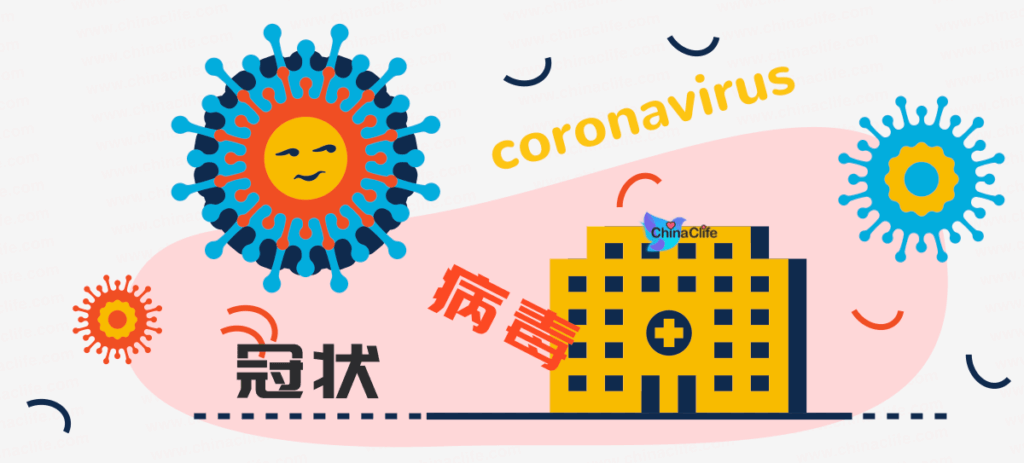HOW-TOs
HOW TO SAY CORONAVIRUSES AND VIRAL INFECTIOUS DISEASES IN CHINESE?
| 一些“冠状病毒”和“病毒性流行病”的中文读法
Table of Contents
The novel coronavirus (xīn xíng guān zhuàng bìng dú) is a new type of coronavirus strain that has never been found in the human body before December 2019. 新型冠状病毒 (xīn xíng guān zhuàng bìng dú),是 2019 年 12 月以前从未在人体中发现的一种冠状病毒新毒株。 Since December of 2019, the novel coronavirus infected pneumonia infection spread rapidly in China, with the worst outbreak in the Wuhan city of Hubei province. As of February 3, 2020, 17:01 (GMT +8), the total of novel coronavirus (2019-nCoV) - infected pneumonia diagnosed in China exceeded 17000, and the deaths reached 361, with a fatality rate of approximately 2% to 3%. 自 2019 年 12 月这种新型冠状病毒引发的新型病毒性肺炎在中国迅速蔓延开来,以中国湖北省武汉市的疫情最为严重。截止 2020 年 2 月 3 日 17 时 01 分 (北京时间), 中国境内已确诊的新型冠状病毒肺炎患者人数超过 1.7 万,死亡人数达 361 人,致死率约在 2% - 3%之间。 In early January of 2020, this new virus is known as a novel coronavirus "2019 - nCoV". Later on February 22, the National Health Commission of the People's Republic of China shortened the Chinese name of the novel coronavirus-infected pneumonia disease to be "新冠肺炎 (xīn guān fèi yán)", in company with the formal full Chinese name "新型冠状病毒肺炎 (xīn xíng guān zhuàng bìng dú fèi yán)" as well as the formal English name "COVID-19". Then the name of the disease is officially updated to be "2019 Coronavirus Disease" by the World Health Organization (WHO) on its website. 2020 年 1 月初,这种新型病毒暂时被人们称作 “2019 新型冠状病毒” 。同年 2 月 22 日,中国国家卫生健康委员会 (NHC) 正是将新型冠状病毒引发的肺炎命名为为“新型冠状病毒肺炎 (xīn xíng guān zhuàng bìng dú fèi yán)”,简称“新冠肺炎 (xīn guān fèi yán)”,英文名称为“COVID-19”。在世界卫生组织 (WHO) 官方网站上,该疾病被记录为 “2019 冠状病毒病”。 The incubation period of this disease is typically 3 - 7 days, with a maximum of 14 days. Most of novel coronavirus-infected patients usually have main symptoms like fever, fatigue, cough, and a few have catarrhal and diarrhea symptoms. Some severe patients will experience shortness of breath, septic shock, moderate or low fever or even without any significant fever symptom. 这种新型冠状病毒的潜伏期一般为 3 - 7 天,最长不超过 14 天。感染后大部分人群通常会出现发热、乏力、干咳的主要症状,少数伴有卡他性、腹泻症状。更有严重患者会出现呼吸困难、脓度症休克,中低热或是无明显发热。 In addition, some studies have shown that this novel coronavirus is sensitive to UV and heat. It can be killed if exposed to ultraviolet light or heated at 56 ℃ for 30 minutes long. You can also kill the virus effectively by using ether, 75% medical alcohol, chlorine-containing disinfectant, peracetic acid, chloroform and other fatty solvents (except chlorhexidine). 另外,据研究显示,这种新型冠状病毒对紫外线和热敏感。若通过紫外线照射 或 56 ℃ 加热 30分钟就能杀灭病毒。也可以使用乙醚、75% 医用酒精、含氯消毒剂、过氧乙酸和氯仿等脂溶剂 (氯己定除外) 均可有效消灭活病毒。 As early as 17 years before the outbreak of the 2019's novel coronavirus, the year 2002, also in December around, also in China, but a more serious outbreak of respiratory infectious disease broke out in Guangzhou, the southern city of China. It is called “严重急性呼吸道综合征 (yán zhòng jí xìng hū xī dào zōng hé zhēng)” or "非典型肺炎 (fēi diǎn xíng fèi yán)" in Chinese, or "非典 (fēi diǎn)" for short. It is an acute respiratory infection caused by a SARS coronavirus. 早在新型冠状病毒爆发的 17 年前 ( 2002 年),同样是在 12 月前后,在中国最南部的广州市爆发了一场更严重的呼吸道传染病疫情,在中国被称作是“严重急性呼吸道综合征 (yán zhòng jí xìng hū xī dào zōng hé zhēng)”,又称作“非典型肺炎 (fēi diǎn xíng fèi yán)”,简称“非典 (fēi diǎn)”。它是由一种 SARS 冠状病毒引起的急性呼吸道传染病。 On March 15, 2003, the Word Health Organization (WHO) officially name this infectious disease "SARS", which stands for "Severe Acute Respiratory Syndrome". Its virus is called "SARS - CoV", or "非典病毒 (fēi diǎn bìng dú)" in Chinese. 2003 年 3 月 15 日,世界卫生组织 (WHO) 将这种传染病正式命名为 “SARS”,其全称为 “Severe Acute Respiratory Syndrome”。其病毒也因此称作 “SARS 病毒”,或在中国叫做“非典病毒”,即 “SARS - CoV”。 According to the latest data analytics, if the lethality rate of the novel coronavirus is about 3%, then the lethality rate of the SARS virus in 2002 was over three times above, reaching 10%. In the period of 2002-2003, SARS infected over 8000 people and killed about 800 patients in 27 countries and regions around the world within just 5 months. So far, the specific medicine that can cure SARS hasn't been invented yet. 从当前数据来看,若新型冠状病毒的致死率为 3%,那么当年非典病毒的致死率则是其 3 倍以上,达到 10%。 在 2002 - 2003 年,短短 5 个月之内,非典在全球 27 个国家和地区,造成了超过 8000 人感染,约 800 人死亡。 至今,仍没有可治愈非典的特效药诞生。 However, the studies have shown that the SARS virus that can survive for 4 days at 37 ℃, can be killed by heating at 56 ℃ for 90 minutes, or 75℃ for 30 minutes. 不过据研究显示,非典病毒在 37℃ 的环境下可存活4天,通过 56℃ 加热 90 分钟、75℃ 加热 30 分钟均能够灭活病毒。 In June 2012, a new type of unknown coronavirus MERS virus appeared and spread in Saudi Arabia, which killed many infectors at the time. 在 2012 年 6 月, 一种对于当时来说未知的新型的冠状病毒 MERS 病毒出现在了沙特阿拉伯,并迅速导致不少患者死亡。 This disease is named by the World Health Organization as MERS, and its full English name is "Middle East Respiratory Syndrome" and is called "中东呼吸综合征 (zhōng dōng hū xī zōng hé zhēng)" in China. The virus which caused this infectious disease is called "MERS-CoV", that is "MERS Virus". 这种疾病被世界卫生组织命名为 MERS,其英文全称为 “Middle East Respiratory Syndrome”,在中国被称作是“中东呼吸综合征 (zhōng dōng hū xī zōng hé zhēng)”。 诱发这种传染病的病毒被称为“MERS-CoV”,也就是 MERS 病毒。 Compared to the novel coronavirus from 2019 to 2020 and the SARS virus, the MERS virus is much more horrible. It spread rapidly from the Middle East to 28 countries in 2012 - 2015 and caused approximately 2494 people worldwide to be infected, 858 people to death. The mortality rate reached a horrific figure - 34.4%. 相较于 2019 - 2020 年的新型冠状病毒,以及 SARS 非典病毒, MERS 病毒更加可怕。它在 2012 - 2015 年内从中东地区迅速蔓延至 28 个国家,并导致全球约 2494 人感染上中东呼吸综合征,致死 858 人,死亡率高达一个恐怖的数字 —— 34.4%。 Ebola virus is a rare and infectious disease that can cause humans and other primates to be infected with Ebola hemorrhagic fever (EBHF). It is not a type of coronavirus but originated from southern Sudan and the Ebola region of the Congo in 1976, hence got the name of "Ebola". 埃博拉病毒 (āi bó lā bìng dú),是一种十分罕见的、能引起人类和其他灵长类动物产生埃博拉出血热 (EBHF) 的烈性传染病病毒,并非冠状病毒。它起源于 1976 苏丹南部和刚果 的埃博拉河地区,因此而得名“埃博拉”。 The Ebola hemorrhagic fever caused by the Ebola virus is the most deadly viral hemorrhagic fever disease in the world today, with a mortality rate between 50% and 90%. Between 1976 and 1979, it brutally killed over 10 thousand civilians and families in 9 countries and regions including its origin and Sudan. 由这种病毒引发的埃博拉出血热是当今世界上最致命的病毒性出血热疾病,其死亡率在 50% 至 90% 之间。在 1976 - 1979 年间,及其残忍地虐杀了起源地、苏丹等 9 个国家和地区的上万平民百姓和家庭。 Fortunately, the World Health Organization announced on December 23, 2016, that a vaccine developed by the Public Health Agency of Canada can effectively protect against the Ebola virus. 值得庆幸的是,世界卫生组织于 2016 年 12 月 23 日宣布,由加拿大公共卫生局研发的疫苗可以高效防护埃博拉病毒。 Influenza A (H1N1), was first discovered in 1933 and is one of the varieties of influenza A virus. Because its main host of the virus is "swine", it is also familiar with another calling "Swine Influenza Virus", abbreviated as SIV. In China, the influenza disease caused by this virus is called "甲型流感 (jiǎ xíng liú gǎn)" in the Chinese language, and "甲感 (jiǎ liú)" for short. 甲型 H1N1 流感,最早被发现于 1933 年,是甲型流感病毒的其中一个品种。由于该病毒宿主以“猪”为主,因此由该病毒引发的流感疾病,被大众熟知为“猪流感病毒 (zhū liú gǎn bìng dú)”, 简写为 “SIV”。在中国,被这种病毒引发的流感疾病被称作“甲型流感 (jiǎ xíng liú gǎn)”,简称“甲流 (jiǎ liú)”。 The World Health Organization (WHO) officially renamed this novel viral disease as Influenza A (H1N1) on April 30, 2009. The autumn and winter of each year is the period of a high incidence of this flu. 世界卫生组织于 2009 年 4 月 30 日将这种新型致命病毒性流感更名为甲型 H1N1 流感。每年秋冬季节都是这种病毒以及流感爆发的高峰期。 The most recent and the worst H1N1 Flu outbreak in human beings occurred in the United States in 2009. It eventually spread rapidly across 214 countries and regions worldwide and caused about 284500 deaths around the world, with a mortality rate of 17.40%. 最近的一次甲型 H1N1 流感在人类中的大爆发出现在 2009 年美国,也最为严重。最终造成了甲流在全球 214 个国家内蔓延,并导致全球约 284500人死亡,其死亡率达到 17.40%。 Here are some severe coronavirus and viral infectious diseases above. Did you get them? 这些严重的冠状病毒和病毒性疾病,你学会了吗? Start learning how to say coronavirus and viral infectious diseases in Chinese right now. May all of the people away from them forever and lead a healthy life. 立即开始学习如何用中文读出这些冠状病毒和病毒性疾病的名称。祝愿所有人永远远离他们,过上健康的生活。 Have you got any tips from the bilingual Chinese story above? Do you have any other questions or suggestions? You are free to write down in the "Comments" section below. Any thought from yours could be appreciated, valuable, and might help the rest of the residents on the planet. 😀 Additionally... Did You Start Learning Chinese with Pinyin? Continue to read our User-friendly Chinese-Pinyin version of this story (Unlocked for residents only). Hope it Helps! : ) Tips: The full content to show for Free Logged-in and Premium residents only. Please click Log-In / Sign Up for Free button on the top right to unlock them. See u soon... : )![]()
COVID-19 - Novel Coronavirus Disease
| 新型冠状病毒病
![]()
SARS
| 严重急性呼吸道综合征
![]()
MERS
| 中东呼吸综合征
![]()
Ebola Virus Disease
| 埃博拉病毒病
![]()
Influenza A (H1N1)
| 甲型 H1N1 流感
Questions & Additional
More Stories to Be Continued...














